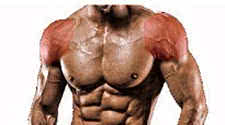Double Edged Deltoids - Split Shoulder Action

Never Neglect Smaller Muscle Groups
Novice bodybuilders are notorious for going overboard on training the biceps and chest. They develop these areas to the exclusion of all others, at least initially, because they are
the show muscles and respond quickly for most trainees. Biceps and chest are not the only premium muscle groups, however. Sometimes the i thighs become the focus of a beginner, and
the quads get overblown. A bodybuilder shows maturity when he or she begins to develop the whole body. Body balance, or symmetry, is a sign of good bodybuilding forethought. Those
with a good knowledge of the sport know the shoulders supply a large part of the balanced look. In fact, the shoulders are so important that they set the pace for both the upper and
lower body. If you want a hot body, you must develop the shoulders to a high degree. Shoulders consist of the triple-headed deltoids, which are visible from all directions. They
are as important for the non competitor as they are for the contest-level bodybuilder.
For some trainees the deltoids are quite responsive. Others find them hard to train and even harder to develop. Many people don't like to train the shoulders because the training is
intense, painful, and requires a great deal of concentration. However, the rewards are well worth the output. A body without significant shoulder development is not hot by anyone's
definition.
The deltoids, like any other muscle group, can get burned out by monotony. Both the mind and the body come to a point where they say "enough." When this happens, the time is ripe for
a little muscle confusion. A break from the typical is good for the body, and especially the deltoids. The double-edged deltoid routine is a rotating weekly duet that works the
deltoids from several angles and varies the attack to keep the muscle guessing and growing.
The first workout for the deltoids consists of 4 sets of dumbbell presses, 2 sets of the Y lift with dumbbells, a 2-set spin on the cable lateral, and a 3-set finish with the bent
lateral. The dumbbell presses should be complete presses. Go slowly, bringing the bells all the way down and all the way up. The deliberate action will pack on some serious muscle, so
don't cheat, especially on that tough fourth set. Stick it out to the end. Rest a minute and proceed to the Y-lift. The Y-lift is a dumbbell movement that imitates an upright row motion
at the bottom, but spreads apart at the top. This exercise hits the side deltoid region well. After 2 sets finish the side deltoids with 2 sets of cable laterals, getting a good burn
through higher repetitions. The bent lateral raises will complete the shoulder workout by targeting the rear deltoid muscles.
Do this session in an intense, highly concentrated manner. Keep your mind focused on the task at hand -that is, hitting the deltoids hard.
The second session comes later in the week when the deltoids have had a chance to recover from the first blowout. Start with the old standard of the behind-the neck press. Yes, it hurts,
and is a difficult movement, but it is very effective. You'll find 3 sets of heavy-duty action to get the shoulders going will be good. Follow this exercise with 4 sets of dumbbell
laterals, resting only minimally between sets. Keep the tension constant to get the greatest possible benefit from the movement. Raise the dumbbells slightly higher than shoulder level
and ease them down, not allowing a rapid descent. You have almost a negative movement when it is done in this manner. Rest for a couple of minutes (you'll need the break) and take a
few gulps of water. Then go to the cable area for some bent cable raises, also known as X lifts.
Stand in the center of a cable setup and with your right hand grasp the left low pulley. Do the opposite with the left hand so that your arms are crossed to form an X. Now bend forward,
easing your arms out even farther, and slowly raise each arm to an upper and outer position, as far up and back as possible while maintaining the bent stance. (Tip: Set your legs wide
apart for a good solid base.) Do this exercise slowly with high repetitions, and focus on letting the rear deltoids do all the work.
The final exercise of the second shoulder session is the front raise for the front deltoids. This movement is a little different from the traditional dumbbell raise. Stand up on a full
incline bench, and use a barbell instead of a dumbbell. Move the bar from thigh level slowly overhead with arms rigid. This technique puts a great deal of tension on the front deltoid
region, but that's what you want for growth. No pain, no gain.
Deltoids are a multiple-angle muscle and to fully train them you need a multilevel attack. Use the double-edge deltoid routine to achieve that all-important hot shoulder development.